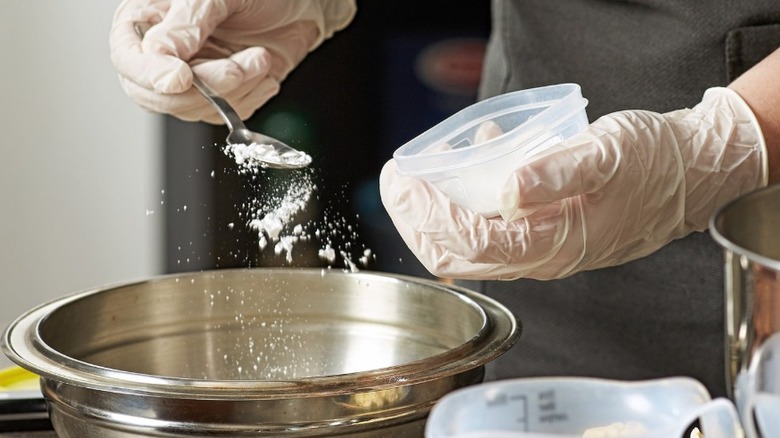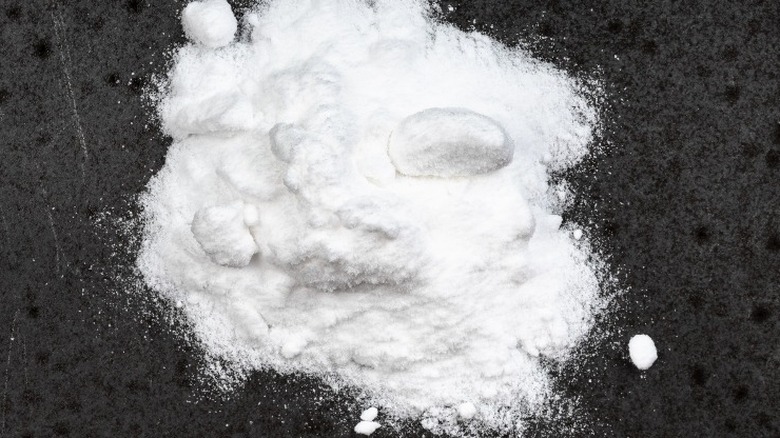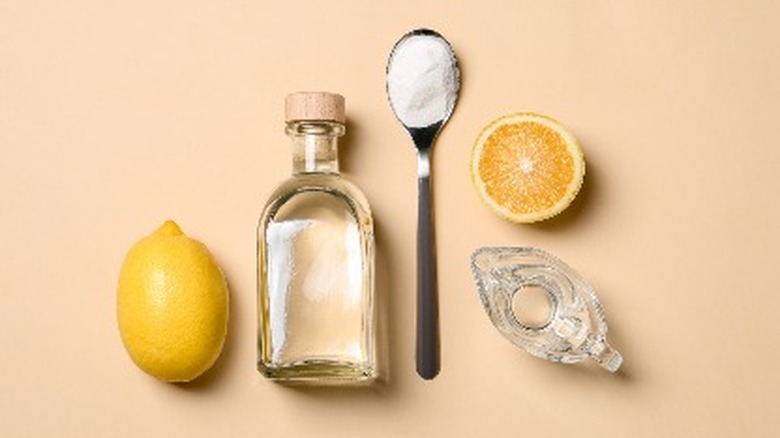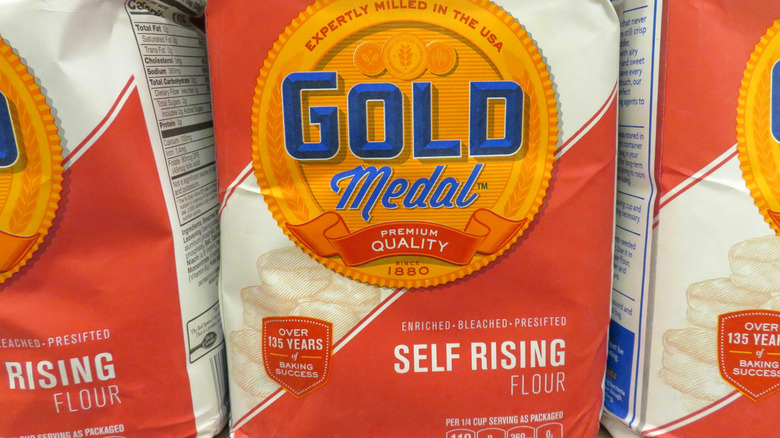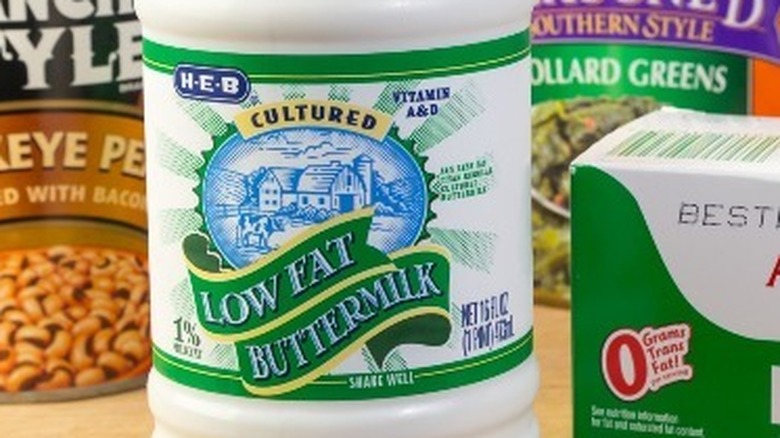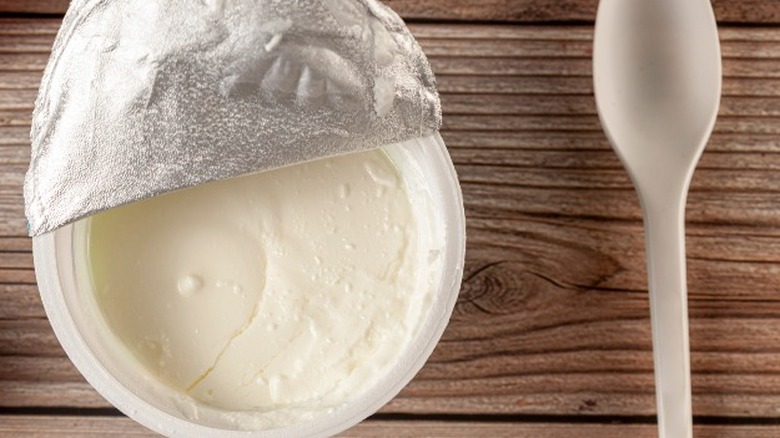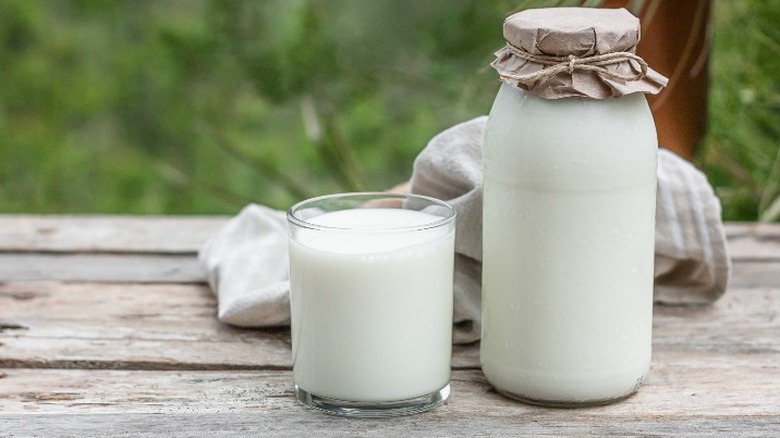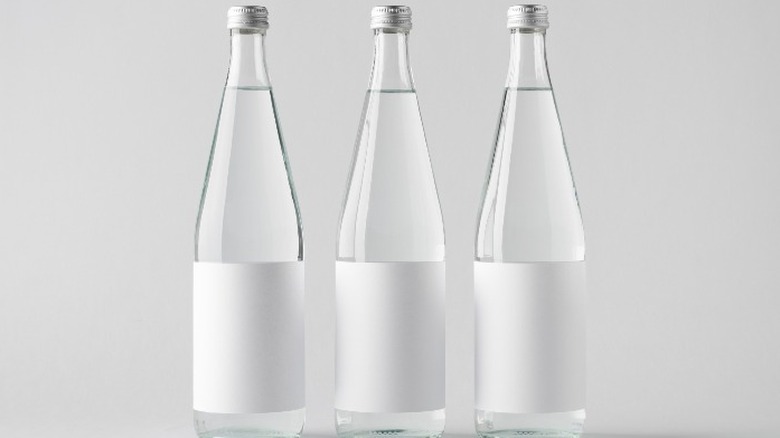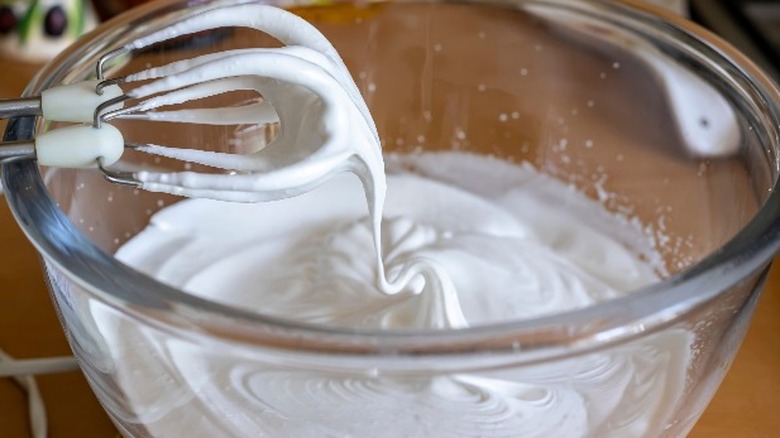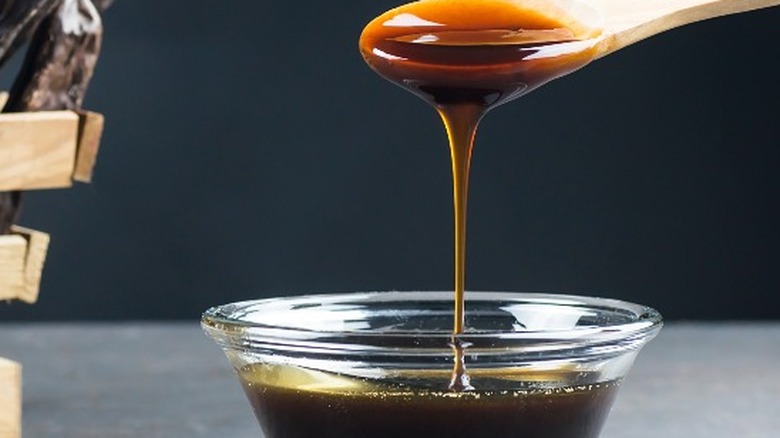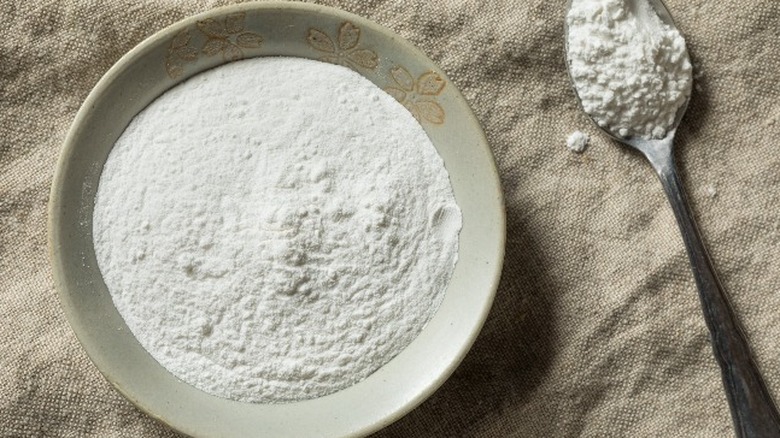10 Best Substitutes For Baking Powder
We may receive a commission on purchases made from links.
Baking requires the mastery of chemistry at its most basic level. Bakers must know how each ingredient will enhance the food, and they'll typically reach for the baking powder when the desired cake result is Dolly Parton-level volume with a feathery light texture.
Baking powder is a chemical leavening agent. According to the Food Network, the powdery white substance is made from sodium bicarbonate, an acid (often cream of tartar), and cornstarch. The chemistry of baking powder occurs when it interacts with liquid, causing carbon dioxide to proliferate within the batter. Essentially, the chemical reaction releases air, causing the batter to rise. Baking soda, on the other hand, contains only sodium bicarbonate. The real difference between baking powder and baking soda boils down to how they react with the other components in a recipe. Baking powder doesn't need an acid to release Co2 bubbles in dough, but it does need a liquid. Baking soda requires an acid for that same effect.
If you discover that you don't have baking powder on hand, or yours has expired, you have some alternatives. Here are 10 options for such occasions.
1. DIY baking powder
The baking powder rule you should never break is to always use a fresh box that hasn't become deactivated with age. If you discover that your baking powder has expired, check your pantry for baking soda, cream of tartar, and cornstarch. These are the ingredients that comprise baking powder, and if you're a prolific baker, you probably have them on hand.
According to Martha Stewart, baked goods leavened with homemade baking powder will have a distinguishable difference in taste to ones made with the store-bought stuff. Stewart swears the homemade version has a slightly less metallic taste than what you can buy at the grocery store.
Smitten Kitchen recommends mixing one part baking soda with one part cornstarch and two parts cream of tartar. The site's rule of thumb for one teaspoon of baking powder is ¼ teaspoon baking soda, ½ teaspoon cream of tartar, and ¼ teaspoon cornstarch.
2. Vinegar or lemon juice
If you don't have the ingredients to make your own baking powder, you can try some other kitchen staples before packing it in or making an emergency run to the grocery store.
White vinegar and lemon juice can also act as a stand-in for baking powder, but you'll need baking soda too. The acids, which have a pungent taste before baking neutralizes them, will react with the baking soda in a recipe, creating a chemical reaction that's similar to baking powder.
If you choose to use vinegar and baking soda as a substitute for baking powder, take into consideration that it may affect the taste ever so slightly. Add a few pinches of sugar to compensate, just to be safe.
Food52 recommends using ¼ teaspoon of baking soda with ½ teaspoon of white vinegar or lemon juice for every teaspoon of baking powder needed. If you're really in a pickle, The Pioneer Woman wrote, you can also use red wine or apple cider vinegar.
3. Self rising flour
One way to creatively substitute another ingredient for baking powder is to swap for products that already contain that ingredient. For example, one cup of self rising flour has about ½ to 1 teaspoon of baking powder, plus ¼ teaspoon of salt already uniformly combined with the flour. You can save dirtying another dish because you won't need to mix these dry ingredients.
Having the leavening agent already mixed into the flour makes the self-rising variety ideal for boxed cakes and other treats you can make on the fly, like this 2-ingredient bagel recipe. Self rising flour is also commonly used for biscuits, scones, and quickbreads.
Believe it or not, the flour has more nutrition than all-purpose flour. But, the self rising variety has a shorter shelf-life (via Bob's Red Mill).
Use a 1:1 ratio of self rising flour to all-purpose flour if you decide to go that route, but make sure your ingredients are within the recommended period before they expire.
4. Buttermilk
When dry ingredients aren't an option, reach for something wet. Buttermilk is a great substitute because of its acidity, so combining it with baking soda ignites the same chemical reaction as in baking powder. According to Healthline, buttermilk occurs as a byproduct of butter when sweet cream is incorporated. Add ½ cup of buttermilk to ¼ teaspoon of baking soda to achieve the equivalent of one teaspoon of baking powder.
Buttermilk has similar qualities to yogurt, particularly the taste. When using buttermilk as a replacement for baking powder, it's crucial to reduce the amount of other liquid you use in the recipe so the texture stays true to its intended consistency. Experts recommend reducing the liquid in the recipe by an amount that's equal to the added buttermilk.
Because of the volume of buttermilk required to activate the baking soda, this substitute is not well suited for recipes that don't call for a substantial amount of liquid to begin with.
5. Plain Yogurt
Buttermilk isn't the only refrigerator resident to make the list of baking powder alternatives. You can substitute yogurt for baking powder, too. Like buttermilk, yogurt needs baking soda to be present in order to spur the chemical reaction you would get out of baking powder. You can use the same formula you would use for buttermilk — ½ cup of buttermilk to ¼ teaspoon of baking soda to match one teaspoon of baking powder. Yogurt is high in lactic acid, which increases its overall acidity. That's because the milk that yogurt is made of has been fermented, decreasing its pH (per Healthline).
Once you combine your dry ingredients, drop some yogurt and baking soda in a bowl, and mix thoroughly. Add the rest of your wet ingredients, but don't forget to reduce the other liquids so you don't have a runny mess on your hands. Then bake as the recipe specifies, and it's like baking powder was never even necessary.
6. Sour milk
Move over baking powder and make room for your brilliant understudy — sour milk? If you sniff your carton of milk and notice a smell, pause before you pour it down the drain, and consider using it in your next baking project. The real reason you should be saving spoiled milk is that it can be a leavening catalyst if you catch it in the sweet spot, right between the time that it expires and when it curdles.
As milk spoils, it undergoes a process called acidification, per Healthline, which causes pH levels to drop into the acid zone. Then, just like with buttermilk and yogurt, the baking soda kicks in to release those Co2 bubbles.
Follow the same general guidelines as you would with buttermilk and yogurt, using ½ cup of sour milk and ¼ teaspoon of baking soda to match one teaspoon of baking powder. And don't forget to adjust the liquid.
7. Club soda
Whether a cake rises in the oven depends on the presence of Co2 bubbles produced by a baking powder chemical reaction in the batter. If you don't have the real thing, give club soda a try. The ingredients in the fizzy liquid are water and sodium bicarbonate, along with some other additives, which is the real difference between seltzer and club soda. It's essentially liquified baking soda.
Be warned, however, the amount of sodium bicarbonate present in club soda is scant. For best results, apply this substitution in recipes that don't call for excessive rising, and reduce the other liquid in the recipe to account for the club soda.
It's also important to note that when using club soda as a baking powder substitute, you must work quickly before the bubbles dissipate and the water becomes flat (per Today). If the liquid has no bubbles, your baked goods will have no rise. Experts say the best way to go about using club soda in your recipe is to replace one of the liquids with the bubbly alternative.
8. Egg whites
Sometimes, the best option is to avoid chemistry altogether. If you're not in a sciencey mood, opt for egg whites. When whipped, egg whites take on a fluffy texture that is quintessential to a number of baked goods including soufflés and meringues. Whipped egg whites are filled with tiny air bubbles that will translate into your finished product by way of a feather-light texture.
To get that airy quality, crack your egg whites into the bowl of a stand mixer, or you can use a hand mixer, and beat them at an increasing speed until they form soft peaks. Fold the rest of your batter into the egg whites, being careful not to over mix, which can destroy the air bubbles.
The number of egg white necessary for this substitution will vary from recipe to recipe. A good rule of thumb to follow, per MasterClass, is to use two egg whites per one teaspoon of baking powder recommended by the recipe. If you get in the habit of saving them, this is what you can make with leftover egg whites.
9. Molasses
If you feel like going off the beaten path of the recipe you're following, consider substituting molasses for baking powder. Molasses, like many of the alternatives discussed here, is an acid. It's a byproduct of sugar production, and producing it requires fermentation, therefore, when coupled with baking soda, it produces a chemical reaction that releases air bubbles (via Bake it With Love).
Of all the baking powder substitutes, molasses is most likely to alter the flavor of your finished product because of its strong, recognizable taste. The dark color could also impact the appearance of your baked goodies. It's best to use molasses instead of baking powder when creating items that already have a warm or caramel-like flavor profile.
If you plan to use molasses instead of baking powder, use ¼ cup plus one teaspoon of baking soda, and be sure to accommodate for the extra liquid and sweetness by altering your recipe accordingly.
10. Cream of Tartar
By now, you've probably figured out the formula needed to substitute for baking powder when you're in a pinch or feel like straying from your recipe — acid plus baking soda equals the desired result. This baking powder doppelgänger is no exception. Cream of tartar is an acid that's formed during winemaking.
What is cream of tartar really? It's potassium hydrogen tartrate, the scientific name for the white powdery substance, and is commonly used in preparing meringue because it has the power to prevent sugar crystals from forming when whipping egg whites or cream.
If you stick to a ratio of two parts cream of tartar to one part baking soda, you shouldn't be able to tell a difference between the two in a recipe. In fact, the cream of tartar and baking soda combo is the best substitution for the real thing, according to the Pioneer Woman.
